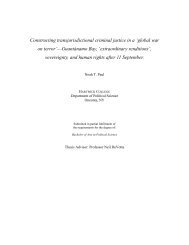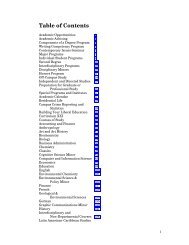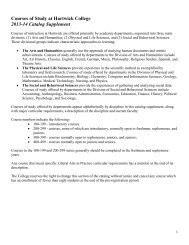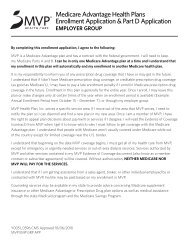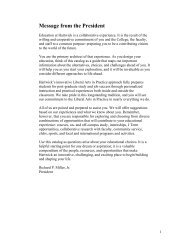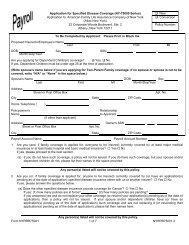Does Technological Innovation Really Reduce ... - Hartwick College
Does Technological Innovation Really Reduce ... - Hartwick College
Does Technological Innovation Really Reduce ... - Hartwick College
Create successful ePaper yourself
Turn your PDF publications into a flip-book with our unique Google optimized e-Paper software.
<strong>Does</strong> <strong>Technological</strong> <strong>Innovation</strong> <strong>Really</strong> <strong>Reduce</strong> Marginal Abatement Costs?<br />
Some Theory, Algebraic Evidence, and Policy Implications*<br />
Yoram Bauman, Whitman <strong>College</strong><br />
Myunghun Lee, Inha University<br />
Karl Seeley, <strong>Hartwick</strong> <strong>College</strong>**<br />
Abstract<br />
The existing literature models innovation in pollution control as a reduction in marginal abatement<br />
costs. We show that this assumption is inappropriate for production process innovations such as fuel<br />
switching. Algebraically, we examine the effects of different innovation types on marginal abatement cost<br />
curves, showing that some desirable innovations increase marginal abatement costs. Empirically, we<br />
estimate marginal abatement costs for sulfur dioxide by measuring the output distance function for<br />
electric power in Korea. Regression results confirm that production process innovations did raise<br />
marginal abatement costs in this case. One policy implication: economic instruments do not always<br />
provide stronger innovation incentives than command-and-control policies.<br />
Keywords: Marginal Abatement Costs, Production Process <strong>Innovation</strong>s, <strong>Technological</strong> Change<br />
JEL codes: O38, Q28<br />
* This paper has not been submitted elsewhere in identical or similar form, nor will it be during<br />
the first three months after its submission to the Publisher. We are grateful to Robert Halvorsen<br />
for valuable comments.<br />
** Corresponding author: Department of Economics, <strong>Hartwick</strong> <strong>College</strong>, Oneonta, NY, 13820,<br />
USA; seeleyk@hartwick.edu; (607) 431-4628.<br />
- 1-
I. Introduction<br />
The possibility that innovation in pollution control can help alleviate the tradeoff between<br />
environmental protection and industrial production has been of significant interest to economists since at<br />
least the mid-1970s, when Kneese and Schultze (1975) wrote that “over the long haul, perhaps the most<br />
important single criterion on which to judge environmental policies is the extent to which they spur new<br />
technology toward the efficient conservation of environmental quality.” 1 Such new technologies can be<br />
end-of-pipe measures, such as installing scrubbers on smokestacks, or production process measures, such<br />
as developing more fuel-efficient boilers or burning coal with lower sulfur content (Hanley et al., 1997).<br />
Following Kneese and Schultz is an extensive theoretical literature (e.g., Downing and White, 1986;<br />
Mendelsohn, 1984; Milliman and Prince, 1989; and Montero , 2002) that examines the incentive<br />
structures created by Pigovian taxes, tradeable permits, command-and-control regulations, and other<br />
environmental policies. A survey by Jaffe et al. (2003) summarizes these findings as indicating that<br />
“market-based instruments for environmental protection provide better incentives than command-andcontrol<br />
approaches for the cost-effective diffusion of desirable, environmentally-friendly technologies.”<br />
The dominant framework for this literature is the graphical approach shown in Figure 1. Papers in this<br />
tradition include Downing and White (1986), Milliman and Prince (1989), Palmer et al. (1995), Jung et al.<br />
(1996), Montero (2002), Parry et al. (2003), Biglaiser and Horowitz (1995), Parry (1998), and Jaffe et al.<br />
(2003). We will call this dominant framework the “marginal” approach because of two of its principal<br />
components. First, innovation is modeled as a reduction in marginal abatement costs, e.g., from MAC 1 to<br />
MAC 2 in Figure 1. Second, the gains from innovation for a firm facing a Pigovian tax of τ is asserted to<br />
be the area bounded by OFCB.<br />
In this paper, we identify some limitations in the marginal approach, especially in the context of<br />
production process innovations. The first limitation comes from the tendency in much of the literature<br />
using the marginal approach to focus on minimizing abatement costs while output is either implicitly or<br />
explicitly held fixed. Firms have a broader goal – profit maximization – and failure to attend to this<br />
broader goal can lead the marginal approach astray. Intuitively, such difficulties will not arise in the case<br />
of innovations in end-of-pipe abatement technology: here profit maximization and abatement cost<br />
minimization are effectively the same problem, and the graphical analysis described above correctly<br />
quantifies the gain from innovation. With production process innovations, however, cost minimization<br />
with output held constant cannot substitute for profit maximization. In these cases, the marginal approach<br />
incorrectly measures the gain from innovation. 2<br />
This paper focuses on a second problem with the marginal approach: it inappropriately limits the<br />
definition of innovation to include only reductions in marginal abatement costs at all margins. The<br />
intuitive appeal of this definition is obvious, but other researchers (e.g., Downing and White (1986),<br />
quoted below in Section II) have acknowledged that the connection between innovation and everywherelower<br />
marginal abatement costs is tenuous, even for end-of-pipe abatement technology. Our main<br />
assertion is that this connection is in fact nonexistent in the case of production process innovations. Such<br />
innovations are likely to increase marginal abatement costs at some margins, and in important cases will<br />
increase marginal abatement costs at all margins.<br />
Section II of this paper provides context: our point is not that innovations that increase marginal<br />
abatement costs have never been discussed, but rather that such innovations are vastly more important<br />
than the literature suggests. Section III uses a simple algebraic model to show how archetypal pollution<br />
control innovations can increase marginal abatement costs. As a result, while end-of-pipe innovations are<br />
unambiguously pollution-reducing, the effect of other innovations depends on preferences for<br />
environmental quality and sometimes on the elasticity of demand for output. Section IV provides<br />
empirical support: we estimate the marginal abatement cost of SO 2 and rate of production process<br />
innovation by measuring the Shephard (1970) output distance function for the Korean electric power<br />
industry. 3 Section V discusses policy implications, e.g., by questioning the superiority of economic<br />
incentive policies in promoting innovation. Section VI contains concluding remarks.<br />
- 2-
II. Context<br />
Three strands of literature relate to the topic at hand. The first is the marginal approach, which goes<br />
back at least as far as Zerbe (1970) and Wenders (1975). As noted above, this literature downplays (but<br />
does not completely ignore) the importance of innovations that increase marginal abatement costs. For<br />
example, Downing and White (1986) point out that innovations might reasonably raise marginal<br />
abatement costs at some margins while lowering them at others, but then dismiss this possibility by noting<br />
that the “more commonly discussed” innovations are those which lower abatement costs at all margins.<br />
More recently, the survey article by Nelissen and Requate (2004) argues that innovations “do not<br />
necessarily lead to declining marginal abatement costs” but also notes that declining marginal abatement<br />
costs are assumed “in most of the literature.”<br />
A second strand of literature (an early example is Magat, 1978) uses frameworks other than the<br />
marginal approach to study incentives for innovation. In particular, Requate (1998) and Requate and<br />
Unold (2003) criticize the “partial-partial” nature of the dominant approach and instead use models that<br />
allow for consideration of entry/exit and other general equilibrium effects. Valuable though these<br />
contributions are, they fail to highlight what we see as a fundamental shortcoming in the marginal<br />
approach: the association of innovation with lower marginal abatement costs. Indeed, one paper that<br />
avoids the marginal approach (Requate, 1995) is so focused on output effects that it claims that it does<br />
follow the marginal approach. 4<br />
A third strand of literature considers innovation in the context of other issues such as macroeconomic<br />
growth (Gradus and Smulders, 1996; Smulders, 1999) or international trade (Ulph and Ulph, 1996; di<br />
Maria and Smulders, 2004). The macro models incorporate some form of “resources” or “pollution” as an<br />
input to production. In different ways, these models have investigated whether innovations are<br />
“pollution-using” or “pollution-saving,” analogous to the established classification of technological<br />
change as labor-using or labor-saving (see, e.g., Burmeister and Dobell, 1970). In general, this literature<br />
tends to find that innovation increases the marginal benefit of pollution and thus in many situations will<br />
lead to an increase in the optimal level of pollution. Our paper emphasizes the possibility and importance<br />
of similar situations in the microeconomic context typically used for the theory of environmental policy.<br />
The extensive literature on instrument choice in environmental policy is dominated by microeconomic<br />
models, so those models need to accurately reflect the effects on costs of different types of innovations.<br />
As a final piece of context, it is worth noting an ambiguity about the phrase “innovation in pollution<br />
control.” Some authors (e.g., Wenders, 1975) clearly limit their analyses to innovations in end-of-pipe<br />
abatement technologies. Others are not so clear: for example, Zerbe (1970) focuses on end-of-pipe<br />
abatement but also brings up fuel switching, thereby extending the scope of his analysis to include<br />
innovations in production processes.<br />
The resulting ambiguity arguably exists to this day. Many papers (e.g., Milliman and Prince, 1989)<br />
discuss “innovation in pollution control” without clarifying the intended scope of this phrase. In some<br />
papers, brief comments hint at generality; examples include Zerbe's mention of fuel switching and Parry's<br />
(1998) footnote referring to “the substitution of natural gas for coal.” In other papers, it is not clear<br />
whether the authors are interested only in innovations in end-of-pipe abatement technologies or also in<br />
production process innovations.<br />
What is clear is that the results of these analyses have been widely applied to both types of innovation.<br />
For example, Hahn and Stavins (1991) cite Milliman and Prince (1989) in asserting that “incentive-based<br />
policies have been shown to be more effective in inducing technological innovation and diffusion…than<br />
conventional command-and-control approaches.” The survey article by Jaffe et al. (2003) explicitly<br />
mentions “process innovation” and considers a “hybrid motor vehicle engine” as a potential innovation.<br />
An even clearer example is the reliance on the marginal approach in Palmer et al. (1995). Their paper is a<br />
rebuttal of Porter and van der Linde's (1995; see also Porter, 1991) defense of the Porter Hypothesis, a<br />
defense that emphasizes the importance of production process innovations.<br />
Our work emphasizes the importance of clarifying the scope of the phrase “innovation in pollution<br />
control.” To the extent that research is focused exclusively on end-of-pipe abatement technologies, the<br />
marginal approach may not be inappropriate. But most research and policy work appears to encompass<br />
- 3-
production process innovations as well as end-of-pipe measures, and in this case—as we show in the next<br />
two sections—the marginal approach has significant shortcomings.<br />
III. Algebraic Demonstration<br />
We construct our model along the same lines as Nelissen and Requate (2004), using a function C(e) to<br />
represent the “cost” of emissions. This cost is the difference between the maximum profit in an<br />
unregulated situation, where firms will choose e max , and profit when emissions are constrained to some<br />
level e < e max . 5<br />
Output is determined by the production function q = f(x, δ), where x is the input and δ is a productivity<br />
parameter. The production function has conventional properties with respect to the input (f x > 0, f xx < 0).<br />
Increases in δ, which can be thought of as “productivity innovations,” increase both the output and the<br />
marginal product of the input (f δ > 0, f xδ > 0).<br />
A cleanliness parameter ω governs the relationship between the amount of input used and the amount<br />
of gross emissions s (that is, emissions before end-of-pipe abatement efforts): 6<br />
s = 1 x.<br />
ω<br />
Increases in ω, which can be thought of as “cleaner-production innovations,” reduce the level of gross<br />
emissions per unit of input.<br />
End-of-pipe abatement is the difference between gross emissions, s, and final emissions, e, and the<br />
1<br />
cost of that abatement is given by A(<br />
s − e)<br />
. The term α is our final innovation parameter; increases in<br />
α<br />
α, which can be thought of as “clean-up innovations,” reduce the cost of cleaning up gross emissions. We<br />
assume that end-of-pipe costs increase at an increasing rate, and that cleaning up nothing costs nothing:<br />
A′ > 0, A″ > 0, A(0) = 0.<br />
Denoting the price of inputs by z, the full profit function becomes<br />
π<br />
1 ⎛ 1 ⎞<br />
= pf( x,<br />
δ ) − zx − A⎜<br />
x − e ⎟ . (1)<br />
α ⎝ ω ⎠<br />
The firm’s choice of x when e is unrestricted yields values of x max , e max , and π max . Under these<br />
circumstances it cannot make sense to spend money on end-of-pipe abatement, so e ≡ s, A(0) = 0, and x max<br />
is found by differentiating<br />
π = pf( x,<br />
δ ) − zx<br />
(2)<br />
with respect to x. e max is then 1/ω x max , and π max = pf(x max , δ) – zx max .<br />
To find the restricted profit function π(e), we first define the choice of input x as a response to an<br />
exogenous e. Differentiating equation (1) with respect to x and setting the result equal to zero gives us<br />
- 4-
1 1 ⎛ 1 ⎞<br />
pf x<br />
( x,<br />
δ ) − z = A′<br />
⎜ x − e ⎟ , (3)<br />
α ω ⎝ ω ⎠<br />
and we can solve this equation to get x(e), the optimal quantity of input for any limited amount of e.<br />
An examination of (3) establishes the intuitively appealing proposition that x′(e) > 0 (as more emissions<br />
are allowed, input – and output – go up).<br />
Arriving finally at C(e) = π max – π(e), the specific component functions assumed here lead to<br />
1 ⎛ 1<br />
⎞<br />
C( e) = p ⎡⎣<br />
f( xmax, δ ) − f ( x( e), δ ) ⎤⎦<br />
− z [ xmax<br />
− x( e) ] + A⎜ x( e)<br />
− e ⎟<br />
α ⎝ ω<br />
⎠ . (4)<br />
As with x(e), the parts of C(e) display some intuitively appealing traits. As e goes down, you give up<br />
more output (because x(e) goes down), save a little on input (for the same reason) and spend more on endof-pipe<br />
abatement. This last follows from the assumptions of f xx < 0 and A″ > 0, which mean that there’s a<br />
balance between the increasing marginal foregone revenues from less production and the increasing<br />
marginal cost of end-of-pipe abatement. These assumptions also mean that C′ (e) < 0 and C″ (e) > 0<br />
(because further reductions in e can only be achieved by ever-more costly sacrifice of output, or evermore<br />
costly end-of-pipe abatement). C(e) has its maximum at e = 0 and declines continuously to C(e max )<br />
= 0.<br />
The analysis now proceeds by examining changes in e max and π max and C(0) in response to different<br />
kinds of innovations. For end-of-pipe and cleaner-production innovations, the quantity of the good<br />
produced in the unregulated case is unaffected by the innovation, so we simplify the analysis by assuming<br />
a fixed output price. We relax that assumption when examining productivity innovations.<br />
End-of-pipe improvements<br />
We start with an α-innovation. In the absence of regulation, no end-of-pipe abatement will be done,<br />
regardless of how cheap it is, so α-innovations do not change e max or π max . Denoting the original cost as<br />
C 1 (e) and the post-innovation cost as C 2 (e), this tells us that the horizontal intercepts of C 1 (e) and C 2 (e)<br />
are the same. At the other end of the cost function, C 2 (0) < C 1 (0); if nothing else, the firm could choose<br />
the same x(0) as before and clean up the resulting s at lower cost, but with continuous functions for f(⋅)<br />
and A(⋅), it will in fact choose a slightly higher x(0) and cheaply clean up the greater gross emissions that<br />
result. In any case, the innovation leaves unregulated profit unchanged while increasing the profit from<br />
zero emissions, thus reducing the cost of zero emissions. Translating these cost functions to marginal cost<br />
functions, the innovation leaves the horizontal intercept of the marginal abatement cost curve unchanged<br />
while dropping all other values for marginal abatement cost. It is the classic “reduced marginal abatement<br />
cost” assumed in most of the microeconomic literature, illustrated in Figure 1. For clarity and intuitive<br />
appeal, we prefer to look at the problem in terms of “marginal emissions benefits” (MEB), as in Figure 2;<br />
zero abatement in Figure 1 corresponds to maximum emissions in Figure 2, and maximum abatement in<br />
Figure 1 corresponds to zero emissions in Figure 2.<br />
Cleaner-production<br />
Increases in ω have no effect on x max (or, in turn, on π max ) because ω, like α, is missing from equation (2).<br />
1<br />
But since emax<br />
= s( xmax)<br />
= xmax, e max is reduced. This tells us that the horizontal intercepts of both<br />
ω<br />
the abatement cost curve and the marginal abatement cost curve are shifted leftward by ω-innovation.<br />
- 5-
The other end of the curves is trickier. Start by considering a case in which there is no end-of-pipe<br />
technology, so zero emissions means zero profits, regardless of any increases in ω. Since π max is the same<br />
before and after innovation, and C(0) is also unchanged by the new technology, C 1 (e) and C 2 (e) both start<br />
from the same vertical intercept. C 2 (e) then falls more quickly to reach its horizontal intercept.<br />
Translating this to marginal abatement cost curves, the post-innovation curve must be steeper than the<br />
original curve. Furthermore, the area under both marginal curves must be equal, since that area is the<br />
value of C(0), which is also the unchanged π max . This implies that the vertical intercept of the postinnovation<br />
marginal curve must be higher than on the original marginal curve. We refer to this as “frontloading”<br />
the marginal benefits of emissions: the marginal benefits of the first units are raised by the<br />
innovation, but they fall at a faster rate so as to reach zero at a lower level of emissions than preinnovation.<br />
This is shown in Figure 3.<br />
What if end-of-pipe abatement is possible? This complicates the left end of the cost curve because endof-pipe<br />
abatement acts as a backstop to curtailing production. If abatement costs are low enough, it can<br />
be profitable to produce a positive amount of output and then clean up all the gross emissions that result.<br />
In other words, it is possible to have C 1 (0) < π max if π 1 (0) > 0. But we also know that π 2 (0) > π 1 (0),<br />
because even if x(0) were unchanged there would be fewer gross emissions to clean up and therefore<br />
smaller end-of-pipe abatement costs after the innovation; in fact, with continuous functions there’s some<br />
increment of x that is warranted by the ω-innovation, trading off some of the reduced clean-up for<br />
increased production, making the increase in profits even larger than the comparison with an unchanged<br />
x(0).<br />
If production is profitable at zero emissions in the post-innovation scenario, then part of the argument<br />
used to explain Figure 3 falls away. In this case we know that C 2 (0) < C 1 (0), so the area under the<br />
marginal abatement cost curve post-innovation is smaller than it is pre-innovation and the vertical<br />
intercept of the post-innovation curve does not necessarily lie above that of the pre-innovation curve. In<br />
general, high end-of-pipe abatement costs will push π(0) toward zero, preserving the “front-loading”<br />
situation, while lower end-of-pipe abatement costs bring C 2 (0) down below C 1 (0), and the bigger that<br />
difference is, the more likely it is that the post-innovation marginal cost curve does not cross the preinnovation<br />
curve, as illustrated in Figure 4.<br />
Productivity innovations<br />
As explained above, the two types of innovations explained so far have no impact on output decisions in<br />
the absence of regulation, so we simplified the analysis by assuming a fixed output price. 7 With δ-<br />
innovations, however, changes in the unregulated output quantity are almost guaranteed, so a fixedoutput-price<br />
assumption is too big a simplification.<br />
Making the output price flexible, equation (2) becomes<br />
π<br />
[ f( x,<br />
δ )] f(<br />
x,<br />
δ − zx<br />
= p )<br />
and x max is now determined by<br />
p′ ( ⋅)<br />
f ( ⋅)<br />
f(<br />
⋅)<br />
+ p(<br />
⋅)<br />
f ( ⋅)<br />
z. (5)<br />
x x<br />
=<br />
By the assumptions about the form of f(⋅), we know that increases in δ increase both f and f x ; we can<br />
also assume that the inverse demand function is negatively sloped. So the second term on the LHS says<br />
we should increase x max in response to an increase in δ, while the first term says we should decrease it. If<br />
demand is highly elastic then the magnitude of p′ is small and the second term dominates, leading to an<br />
- 6-
increased x max ; the more inelastic the demand, the more likely it is that the first term dominates. This<br />
gives us two cases: in Case A, demand is relatively elastic and x max (and e max ) move to the right as δ<br />
increases, while in Case B, demand is relatively inelastic, so x max and e max move to the left. In either case,<br />
π max increases with a δ-innovation. 8<br />
The behavior of e max determines the lower end of the new marginal emissions benefit curve. At the<br />
other end of the curve, an increase in productivity has an ambiguous effect. The “cost” of having zero<br />
emissions is C(0) = π max - π 0 . We know that π max increases as δ grows, but increased productivity also has<br />
a non-decreasing effect on π(0), so the net effect on C(0) is not clear. As before, we denote the original<br />
cost as C 1 and the post-innovation cost as C 2 . It is at least plausible that C 2 (0) > C 1 (0) (zero emissions<br />
represent greater foregone profits after innovation than before), and this is true regardless of whether e max<br />
increases or decreases following an increase in δ. Now consider an instance of Case A where output<br />
demand is just sufficiently elastic to move e max slightly to the right, while at the same time C 2 (0) is<br />
significantly greater than C 1 (0) . This means that the area under MEB* must be significantly greater than<br />
the area under MEB, since these areas are C 2 (0) and C 1 (0), respectively. That in turn implies that the<br />
vertical intercept of MEB* is higher than the vertical intercept of MEB, while the increase in e max moves<br />
the horizontal intercept to the right. Figure 5 illustrates this instance of Case A.<br />
However, with a smaller difference between C 2 (0) and C 1 (0), including all instances in which C 2 (0) <<br />
C 1 (0), the vertical intercept of MEB* will lie below the vertical intercept of MEB, though with the<br />
horizontal intercept moved to the right by the increase in e max . This is illustrated in Figure 6, and can be<br />
thought of as “back-loading” the marginal benefits of emissions: the marginal benefit falls on the earlier<br />
units while rising on the later ones.<br />
Turning to Case B, the marginal abatement curve has its horizontal intercept moved to the left by<br />
increases in productivity. As before, the relative size of C 2 (0) and C 1 (0) determines the shift in the<br />
vertical intercept. In all cases where C 2 (0) is bigger, and also where C 2 (0) is smaller but not by too much,<br />
the vertical intercept of MEB* will be higher, and the situation is qualitatively identical to the “frontloading”<br />
scenario described for cleaner-production innovations and illustrated in Figure 3. Where C 2 (0) is<br />
sufficiently small, the vertical intercept moves down, and we again have the situation illustrated in Figure<br />
4.<br />
In sum, the marginal approach, depicted graphically as in Figure 1 or Figure 2, is only applicable to<br />
end-of-pipe innovations, where the unregulated outcome (A = 0 in Figure 1, or e max in Figure 2) is<br />
unaffected by adoption of the new technology. In all other cases (except by coincidence), these points<br />
will shift in one direction or another, so analyses based on pivoting the MAC or MEB curve around a fixed<br />
horizontal intercept may lead to incorrect conclusions. Instead, the appropriate curve from among Figures<br />
3 through 6 will be a better guide.<br />
Implications for the optimum<br />
With this more diverse set of marginal abatement cost curves, more interesting possibilities arise. With α-<br />
innovations we see unambiguously that the new social optimum is cleaner than the old one (the optimal<br />
level of e goes down). The same is true for cleaner-production innovations and productivity-enhancing<br />
innovations that shift MEB inward, as illustrated in Figure 4. In some other δ-innovations, however, it is<br />
most likely that the optimal level of pollution goes up, as marginal abatement costs are everywhere or<br />
almost everywhere higher than before. And with both the “front-loading” examples (some instances of<br />
Case B of δ-innovation and most instances of ω-innovation), and the “back-loading” examples (the<br />
remaining instances of Case B of δ-innovation) the result depends on where the marginal abatement<br />
benefit curve (or equivalently, the marginal emissions damages curve) falls. The steeper the damages<br />
curve, the more likely we are in the upper region of the marginal abatement cost curve. With “front-<br />
- 7-
loaded” marginal emissions benefits, this is where innovation raises marginal costs, thus leading to a<br />
more polluted social optimum; with “back-loaded” marginal emissions benefits, this upper region is<br />
where innovation reduces marginal costs, leading to a less polluted social optimum.<br />
Two things are important to point out here. The first is somewhat counterintuitive: when dealing with<br />
“front-loaded” curves, the more serious the environmental problem (i.e., the steeper the marginal<br />
emissions damage curve), the more likely the social planner is to respond to an innovation by choosing<br />
more pollution. To the extent that this makes sense, it’s that the social optimum in the face of a serious<br />
problem is highly restrictive of consumption, so it is reasonable to take the opportunity the new<br />
technology affords to increase consumption considerably with only moderate increases in pollution, rather<br />
than accepting a small increment to our miserly consumption and improving the environment further. 9<br />
The second point to make concerns the connection between preferences and whether a technology is<br />
pollution-increasing or pollution-saving. The steepness of the emissions damage curve is partly a<br />
function of the physical damage caused, but also partly a function of the value put on that damage by<br />
people – a function of our preferences. And the distinction between Cases A and B of δ-innovation rests<br />
on the elasticity of demand for the output, which is another way that preferences play a role. This means<br />
that α-innovations are unambiguously pollution-reducing whereas most other innovations, whether δ or<br />
ω, are not in themselves either pollution-reducing or pollution-increasing but interact with our preferences<br />
to have one effect or the other.<br />
In all of this we simplify by modeling an industry that is monolithic in its adoption decision and by<br />
letting industry profit be implicitly synonymous with the gross social benefit from pollution, which is<br />
then balanced against the social cost of pollution captured in the marginal emissions damage curve. There<br />
is fertile ground in relaxing this simplification, but we leave that for future explorations.<br />
IV. Empirical Evidence<br />
Conducting an empirical test of the validity of the algebraic demonstration requires the estimation of<br />
marginal abatement costs and rates of production process innovation. For these purposes we use<br />
Shephard's (1970) output distance function. We investigate the Korean electric power industry, which was<br />
totally dependent on fuel switching – i.e., the use of lower sulfur fuel or natural gas – until 1998; this fact<br />
enables us to eliminate the possibility of innovations in end-of-pipe abatement technology, thus<br />
simplifying the analysis. 10<br />
IV.1 Measurement of the Output Distance Function<br />
Consider a production technology of producing a vector of outputs, y ∈<br />
∈<br />
N<br />
R<br />
+ . The vector of outputs not only includes desirable ones, y 1 ∈ R<br />
H +<br />
M − H<br />
+<br />
M<br />
R<br />
+ with a vector of inputs, x<br />
, but undesirable ones, y 2 ∈<br />
R , which are generated as by-products, so that y = [y 1 , y 2 ]. The output set, B(x), is the set of all<br />
output vectors that are technically feasible with x. Following Färe et al. (1993) and Coggins and Swinton<br />
(1996), we assume that the technology satisfies weak disposability; that is, if y ∈ B(x), then θy ∈ B(x) for<br />
every θ ∈ [0,1], implying that y 2 cannot be reduced without a sacrifice of reduction in y 1 .<br />
For the purpose of analyzing rigorously, we employ the output distance function introduced by<br />
Shephard (1970). Allowing for technological change, this function is defined as<br />
O( x,<br />
y,<br />
t)<br />
= inf{ µ :(<br />
y/<br />
µ ) ∈ B(<br />
x)},<br />
(6)<br />
where t is the time index and y ∈ B(x) if and only if O(x, y, t) ≤ 1. The distance function is monotonically<br />
non-increasing in x, non-decreasing in y 1 , and non-increasing in y 2 . It is also homogenous of degree one in<br />
- 8-
y. The value of the output distance function measures the maximal proportional inflation of the output<br />
vector required to attain the frontier of the technology given the input vector. Note that technically<br />
efficient production is achieved as O(x, y, t) = 1.<br />
The rate of technological change, defined as the rate at which outputs can be proportionally expanded<br />
over time with inputs held constant, is calculated as<br />
RT =<br />
−<br />
∂O(<br />
x,<br />
y,<br />
t)<br />
∂t<br />
(7)<br />
Since regaining technically efficient production demands more outputs, the value of the derivative itself<br />
would be negative.<br />
The revenue function is defined as the maximized revenue subject to the value of the output distance<br />
function<br />
R( x,<br />
p,<br />
t)<br />
= max<br />
y<br />
{ py:<br />
O(<br />
x,<br />
y,<br />
t)<br />
≤ 1},<br />
(8)<br />
M<br />
where p ∈ R is a vector of output prices. Following Färe et al. (1993), we derive the vector of output<br />
prices by applying the envelope theorem on the first order conditions for the Lagrangian problem for<br />
equation (5):<br />
p = R( x,<br />
p,<br />
t)<br />
⋅ ∇ O(<br />
x,<br />
y,<br />
t).<br />
(9)<br />
The use of a dual output distance function, defined as O(x, y, t) = sup p {py: R(x, p, t) ≤ 1}, and Shephard’s<br />
lemma yields<br />
∇ O( x,<br />
y,<br />
t)<br />
p*(<br />
x,<br />
y,<br />
t),<br />
(10)<br />
y<br />
=<br />
where p* (x, y, t) is a vector of revenue maximizing output prices or normalized output shadow prices.<br />
Substituting (10) into (9) we obtain<br />
y<br />
p = R( x,<br />
p,<br />
t)<br />
⋅ p*(<br />
x,<br />
y,<br />
t).<br />
(11)<br />
Let p 1 and p 2 denote the vectors of undeflated shadow prices for desirable and undesirable outputs,<br />
respectively. Assuming that the observed price of one desirable output, y 11 , equals its shadow price, p 11 ,<br />
we can calculate the shadow price of each undesirable output, y 2i , for i = M-H,…, M as<br />
∂O(<br />
x,<br />
y,<br />
t)/<br />
∂ y2i<br />
p2 j<br />
= p11<br />
⋅<br />
≥ 0<br />
(12)<br />
∂O(<br />
x,<br />
y,<br />
t)/<br />
∂y<br />
This shadow price can be interpreted as the opportunity cost of reducing an additional unit of undesirable<br />
output in terms of forgone desirable output, which is equivalent to the marginal cost of pollution<br />
abatement to the producer (Coggins and Swinton, 1996; Hailu and Veeman, 2000).<br />
To compute p 2j in equation (12), a parameterization for O(x, y, t) is needed. Suppose that the output<br />
distance function takes a translog functional form<br />
11<br />
lnO(<br />
x,<br />
y,<br />
t)<br />
= α<br />
+<br />
0<br />
N<br />
+<br />
M<br />
∑ ∑<br />
N<br />
∑<br />
i = 1 j = 1<br />
i = 1<br />
γ<br />
α<br />
ij<br />
i<br />
ln x<br />
i<br />
i<br />
+<br />
M<br />
∑<br />
ln x ln y<br />
j = 1<br />
j<br />
β<br />
j<br />
ln y<br />
j<br />
+<br />
1<br />
+ α<br />
tt<br />
+ α<br />
2<br />
1<br />
2<br />
tt<br />
t<br />
2<br />
N<br />
∑ ∑<br />
i = 1 i'<br />
= 1<br />
+<br />
N<br />
N<br />
∑<br />
α<br />
α<br />
ii'<br />
ln x ln x<br />
∑<br />
it i<br />
i = 1 j = 1<br />
i<br />
tln<br />
x<br />
+<br />
i'<br />
M<br />
+<br />
1<br />
2<br />
jt<br />
M<br />
M<br />
∑ ∑<br />
j = 1 j'<br />
= 1<br />
β tln<br />
y ,<br />
j<br />
β<br />
jj'<br />
ln y<br />
j<br />
ln y<br />
j'<br />
(13)<br />
- 9-
where i, i’ indexes inputs and j, j’ indexes desirable and undesirable outputs.<br />
Following Aigner and Chu (1968), a linear programming technique can be used for the computation of<br />
the parameters in equation (13). The objective function, ∑<br />
T<br />
t = 1<br />
ln O(<br />
x,<br />
y,<br />
t)<br />
is maximized under a number of<br />
constraints, where t =1,…, T indicates the observations. Specifically, (i) ln O (x, y, t) ≤ 0, since O (x, y, t)<br />
≤ 1. For the monotonicity condition, (ii) ∂ ln O (x, y, t) / ∂ ln x ≤ 0, ∂ ln O (x, y, t) / ∂ ln y 1 ≥ 0, and ∂ ln<br />
O (x, y, t) / ∂ ln y 2 ≤ 0. For the imposition of linear homogeneity in outputs, (iii) β<br />
j<br />
= 1,<br />
M<br />
∑<br />
j'<br />
= 1<br />
β<br />
M M<br />
jj' = ∑ γ<br />
ij<br />
= ∑ β<br />
jt<br />
=<br />
j = 1 j = 1<br />
0. Finally, (iv) α ii’ = α i’i and β jj’ = β j’j for symmetry.<br />
IV.2 Data and Empirical Results<br />
We use annual time-series data for the Korean fossil-fueled electric power industry over the period<br />
1970-98. The model consists of one desirable output (electricity), one undesirable output (sulfur dioxide),<br />
and three inputs (capital, labor, and fuel). The electricity output (Q) is measured in 10 3 GWh. The capital<br />
input (K) is the value (in trillion wons, Korean currency) of total assets, deflated by the consumer price<br />
index (1995 =100). The fuel (F) and labor (L) inputs are measured in trillion Kcal and annual average<br />
number of employees, respectively. The price of electricity (p Q ) is an average annual sale price (in wons)<br />
for 1 kWh power, deflated by the consumer price index. All these data are reported in Business Statistics<br />
(published by the Korea Electric Power Corporation). The emissions of SO 2 (S) in 10 6 tons are reported in<br />
the Environmental Statistics Yearbook (published by the Ministry of Environment). Table 1 contains<br />
summary statistics for the data, which are available upon request.<br />
Imposing constraints such as monotonicity, homogeneity, and symmetry, we derive the parameters by<br />
measuring equation (13). Regarding the curvature conditions of the output distance function, all<br />
observations satisfy convexity in outputs and quasi-concavity in inputs. 11 The parameter estimates are<br />
presented in Table 2. These estimates are used to calculate the value of the output distance function for<br />
each year; these are shown in the second column of Table 3. The average value of distance is 0.9924,<br />
indicating that electricity production, on average, could be increased by 0.7 % if plants operated on the<br />
boundary of the production technology.<br />
The use of equation (12) enables us to derive annual estimates of marginal abatement cost for 1 Kg of<br />
SO 2 (MAC t ); these appear in the third column of Table 3. The values of MAC t vary from a low of 0 in<br />
1987 and 1998 to a high of 0.399 dollars per kg in 1984. 12 Zero marginal abatement cost indicates that<br />
plants operate on the horizontal segment of the production technology where the quantity of undesirable<br />
output is measured on the horizontal axis; in those years, SO 2 was freely disposed probably due to less<br />
effective monitoring and enforcement. The value of MAC t continuously increased up to 1985; it also<br />
showed a tendency to increase from 1987 (when it had a value of zero) through 1997. The average value<br />
of MAC t is 0.184 dollars per kg over the sample period. 13 This average is about 40% lower than the threeyear<br />
(1990-92) average values for Wisconsin coal-burning electric plants obtained by Coggins and<br />
Swinton (1996).<br />
The estimated yearly rate of technological change, obtained by calculating equation (7), is presented in<br />
the fourth column of Table 3. The annual values of RT t are mostly positive over the sample period. The<br />
value of RT t steadily increased from -0.36 percent in 1970 to 2.47 percent in 1978, trended downward<br />
during the period 1978-90, and then trended upward until 1997. The average rate of technological change<br />
is 1.12 percent over the period 1970-98.<br />
The average annual SO 2 emission rates (ER t ) in grams of SO 2 per 10 3 Kcal of fuel input are reported in<br />
the fifth column of Table 3. Throughout the 1970s, the annual emission rate was steady at about 7 grams<br />
SO 2 per 10 3 Kcal. Thereafter it fell consistently due to more stringent sulfur regulations. Until 1998, the<br />
M<br />
∑<br />
j = 1<br />
- 10-
plants were required to use low-sulfur fuels to comply with tightened concentration limits on SO 2<br />
emissions.<br />
In order to analyze the factors that might affect the annual marginal cost of SO 2 abatement, we make a<br />
simple OLS regression of MAC t on RT t and ER t . 14 But, error terms are found to have second order<br />
autocorrelation and, as a result, the second order autoregressive model is employed: 15<br />
MAC<br />
t<br />
= −0 .116 + 0.152RTt<br />
+ 0. 027ERt<br />
+ ε<br />
t<br />
(14)<br />
(0.136) (0.029) (0.024)<br />
where the value of R 2 is 0.74 and the numbers in the parentheses are standard errors. 16 The results indicate<br />
that technological innovation increased marginal abatement cost of SO 2 during the 1970-98 period, which<br />
is statistically significant. An increase in the emission rates also raised marginal abatement cost, but its<br />
coefficient is not statistically significant. 17<br />
The Malmquist index can be decomposed into technical efficiency and technical change components;<br />
the technical change component represents the average of RT for periods t–1 and t. The result of an OLS<br />
regression of MAC t on the average of RT is<br />
MAC<br />
t<br />
= −<br />
− 005<br />
0 .007 + 0.187RT<br />
t 1 , t − 0. ERt<br />
+ ε<br />
t,<br />
(0.084) (0.046) (0.015)<br />
where the value of R 2 is 0.66. In comparison with equation (14), the parameter estimate for RT measure<br />
remains little changed in its magnitude, sign, and significance.<br />
V. Policy Implications<br />
Our theoretical and empirical results show that the marginal approach is inappropriate for studying<br />
many types of innovation, especially production process innovations. For one important policy<br />
implication, consider Parry et al. (2003), which questions the importance of technological innovation in<br />
pollution control. Using a theoretical argument based on the marginal approach, they conclude that<br />
“promoting technological innovation appears to be less important than just controlling pollution, contrary<br />
to what some economists previously have speculated. Accordingly, it seems that the primary objective of<br />
environmental policy should be the traditional one of achieving the optimal amount of pollution control<br />
over time—and promoting innovation should be a secondary concern.”<br />
We would argue for a different interpretation. Because Parry et al. base their work on the marginal<br />
approach, their conclusion only applies to innovations that reduce marginal abatement costs. End-of-pipe<br />
measures may fit into this frame, but production process innovations are unlikely to. Our interpretation,<br />
then, is that promoting end-of-pipe innovation may be less important than just controlling pollution. But<br />
there is no limit on the potential gain from production process innovations, which suggests that it is these<br />
innovations that policymakers (and researchers) should focus on.<br />
For a second policy implication, consider the oft-cited advantage that economic instruments have over<br />
command-and-control policies in providing incentives for innovation. The common argument in favor of<br />
economic instruments is that they are “more flexible”: while direct controls constrain firm behavior, e.g.,<br />
by mandating emission limits or specifying abatement technologies, economic instruments give firms the<br />
freedom to take maximum advantage of innovations. More formally, the argument is that the set of<br />
options S D available to a firm facing direct controls is a proper subset of the set of options S E available to a<br />
firm facing economic instruments: S D ⊂ S E . If, for example, direct controls mandate the use of a certain<br />
type of scrubber, the options available to a firm facing economic instruments include but are not limited<br />
to the use of that scrubber; the firm therefore has the flexibility to take advantage of innovations in<br />
scrubber technology (or alternative strategies such as input substitution, e.g., the use of low-sulfur coal). 18<br />
- 11-
Consider a firm with technology T 0 that is considering an R&D investment that will yield technology<br />
T 1 . What is the firm's gain from this innovation under, say, Pigovian taxes, as compared to its gain under<br />
various types of direct controls (abbreviated C & C)? 19<br />
Assume that firm behavior under the two policy regimes is identical prior to innovation. Profits under<br />
the two policies will therefore differ only by the Pigovian tax payment:<br />
0 0 0<br />
π (C&C) = π (tax) + τ ⋅ e ,<br />
(15)<br />
max<br />
where τ is the Pigovian tax rate, e 0 is the pre-innovation firm's emissions level (under both policies), and<br />
i<br />
π<br />
max(<br />
z ) is the maximum profit for a firm using technology T i and facing regulatory policy z. The firm's<br />
gain from innovation (i.e., from the switch from technology T 0 to T 1 ) under policy z can be expressed as<br />
1 0<br />
∆ π ( z)<br />
= π<br />
max(<br />
z)<br />
− π<br />
max(<br />
z).<br />
One can now determine the conditions under which economic instruments<br />
unambiguously provide (weakly) superior incentives for innovation than direct controls, i.e.,<br />
∆ π ( C&C) ≤ ∆ π (tax).<br />
The key issue turns out to be the post-innovation firm's behavior under direct controls, and in particular<br />
its choice of emissions, e 1 . If the firm facing direct controls lowers its emissions (e 1 ≤ e 0 ), the firm facing<br />
the Pigovian tax has the option of mimicry: it could choose to behave in an identical manner and emit e 1<br />
units of emissions. Calling the resulting profits π 1 (tax)<br />
yields<br />
Subtracting equation (15) from equation (16) produces<br />
S<br />
max<br />
1 1 1<br />
π (C&C) = π (tax) + τ ⋅ e .<br />
(16)<br />
max<br />
S<br />
π<br />
1<br />
max<br />
(C&C) −<br />
π<br />
0<br />
max<br />
(C&C) =<br />
≤<br />
≤<br />
π<br />
π<br />
π<br />
1<br />
S<br />
1<br />
S<br />
(tax) − π<br />
(tax) − π<br />
1<br />
max<br />
(tax) − π<br />
0<br />
max<br />
0<br />
max<br />
(tax) + τ ( e<br />
(tax)<br />
0<br />
max<br />
(tax),<br />
1<br />
−<br />
e<br />
0<br />
)<br />
(17)<br />
i.e., ∆ π (C & C) ≤ ∆ π (tax).<br />
Of the two crucial inequalities in this proof, the first arises from our assumption that e 1 ≤ e 0 . The second<br />
1<br />
inequality is essentially tautological: π (tax)<br />
is by definition the maximum profit under a Pigovian<br />
max<br />
tax, so it must be at least as large as any of the firm's other options. It is this second inequality that<br />
encompasses the vaunted flexibility of economic instruments. As long as e 1 ≤ e 0 , Pigovian taxes provide<br />
(weakly) superior incentives for innovation than absolute limits on emissions, limits on emissions per unit<br />
output, technology-based standards, and any other form of direct control.<br />
The proof above also identifies the problem that arises when e 1 > e 0 : mimicry becomes problematic<br />
because economic instruments impose an additional burden on the firm (namely, the cost of additional<br />
emissions) that does not exist under direct controls. The set of profit options available to the firm under<br />
direct controls is no longer a proper subset of the set of profit options available to the firm under<br />
economic instruments. 20 For e 1 > e 0 , the inequality used in (17) no longer holds.<br />
To sum up, if the innovation does increase emissions under direct controls, no general conclusion can<br />
be made: economic instruments such as Pigovian taxes may or may not provide stronger incentives for<br />
innovation than direct controls. As we explore in Sections III and IV, production process innovations are<br />
likely to increase the marginal benefits of emissions, and therefore lead individual firms to increase<br />
emissions in a wide variety of circumstances. As a result, the assertion that economic instruments provide<br />
stronger incentives for production process innovation remains unproven. (This conclusion has also been<br />
reached by Bruneau, 2004.)<br />
- 12-
There is only slightly more clarity when it comes to analyzing different types of direct controls. One<br />
result is this: since individual firms cannot increase emissions under absolute emissions limits, economic<br />
instruments will provide stronger incentives for innovation in this case. But this policy does not dominate<br />
the policy landscape. More prevalent are limits on emissions per unit output, or direct specifications of<br />
technology. 21 Despite claims to the contrary, these policies are not universally inferior to economic<br />
instruments when it comes to providing strong incentives for innovation.<br />
This is a particularly interesting result for technology-based standards, which have frequently been<br />
singled out for criticism, e.g., by Bohm and Russell (1985), Jaffe et al. (2003), and Magat (1978). For<br />
example, the statement by Bohm and Russell, cited in footnote 18, is partially true, in that it applies to<br />
that part of the firm's operations that are covered by the design standard. But a firm required to use a<br />
particular scrubber can still pursue production-process innovations such as more-efficient generators, and<br />
in some cases will have a stronger incentive to pursue those innovations than it would under a Pigovian<br />
tax.<br />
There are two important caveats that must be added to this discussion. First, as pointed out in Requate<br />
and Unold (2003), our analysis takes place in a “partial-partial” world that fails to consider entry/exit or<br />
other general equilibrium effects. Second, our analysis focuses on positive questions about the strength of<br />
various policy tools, not on normative questions about the optimality of those tools. Although papers from<br />
Kneese and Schultze (1975) to Jaffe et al. (2003) contain explicit or implicit suggestions that “more is<br />
better” when it comes to innovation, it is of course possible to have too much of a good thing: at some<br />
point more is not better. Identifying the location of that point is beyond the scope of this paper, but the<br />
issue of optimal—rather than maximal—incentives for innovation is an important one that deserves<br />
further study.<br />
VI. Concluding Remarks<br />
This paper has identified significant limitations in the existing approach to innovation in pollution<br />
control, especially as it relates to production process innovations. Because the marginal approach<br />
inappropriately limits the definition of innovation to include only reductions in marginal abatement costs<br />
at all margins, it applies only to some innovations in end-of-pipe abatement technologies. Since<br />
production process innovations are likely to be crucial in addressing key issues such as agricultural<br />
pollution and global warming, the economics perspective on these topics is incomplete and possibly<br />
misleading.<br />
Our findings have at least one important policy implication. For production process innovations that<br />
increase marginal abatement costs and therefore lead individual firms to increase their emissions, the<br />
superiority of economic incentive policies in promoting innovation over command-and-control<br />
regulations is refutable. Direct controls such as limits on emissions per unit output or technology-based<br />
standards are not universally inferior to economic instruments in providing strong incentives for<br />
innovation.<br />
Beyond that, our work poses a puzzle. In the environmental sciences there is a general concern that we<br />
are not protecting the environment enough. Indeed, while some places have seen improvement in local<br />
indicators such as water quality and air quality, a broader picture incorporating factors such as climate<br />
change, habitat destruction, and species loss suggests that stronger measures would be desirable, if they<br />
could be made “affordable.” Many innovations, both end-of-pipe and process, do just that, in the sense<br />
that we could have more consumption and a healthier environment. What the macroeconomic literature<br />
suggests, reinforced now by our microeconomic model, is that innovations can easily lead to a higher<br />
optimum level of pollution. That is, given the option of polluting less and consuming more, it could be<br />
rational for us to instead pollute more and consume a lot more. 22<br />
There are only two ways of resolving this contradiction. One is the possibility that the natural<br />
scientists are wrong and our environmental problems aren’t that bad. The other is that the comparison of<br />
optima is misleading: yes, optimal pollution post-innovation exceeds optimal pollution pre-innovation,<br />
but we’re currently polluting so much more than the optimal amount that the post-innovation optimum is<br />
less than current emissions.<br />
- 13-
Lastly, our work suggests that whether a new technology is pollution-reducing or pollution-increasing<br />
depends not only on the physical attributes of the technology itself, but also on our preferences, as<br />
captured in the marginal emissions damage curve and the elasticity of demand. Awareness of this could<br />
avoid nasty surprises following the implementation of policy.<br />
What may be called for as future research is an approach that integrates the analysis of innovation in<br />
pollution control into analyses of innovation more generally. Such an approach would encompass both<br />
production process and end-of-pipe innovations. It would also effectively obviate the distinction between<br />
“environmental” and “non-environmental” innovations. 23 Eliminating this distinction could benefit social<br />
welfare analyses, which presumably are interested in both types of innovation. And it would be a fitting<br />
result for environmental economics, many of whose practitioners advocate the use of economic<br />
instruments such as Pigovian taxes to eliminate the distinction between “environmental” and “nonenvironmental”<br />
goods.<br />
- 14-
References<br />
Aigner, D.J., and S.F. Chu (1968), “On estimating the industry production function,” American Economic<br />
Review 58:826-839.<br />
Bauman, Y. (2003), The Effects of Environmental Policy on <strong>Technological</strong> Change in Pollution Control.<br />
Unpublished Ph.D. dissertation, University of Washington, Seattle, Wash.<br />
Baumol, W.J., and W.E. Oates (1988), The Theory of Environmental Policy, 2 nd ed. Cambridge Univ.<br />
Press.<br />
Biglaiser, G., and J.K. Horowitz (1995), “Pollution regulation and incentives for pollution-control<br />
research,” Journal of Economics and Management Strategy 3:663-684.<br />
Bohm, P., and C.S. Russell (1985), “Comparative analysis of alternative policy instruments,” in A.V.<br />
Kneese and J.L. Sweeney, eds., Handbook of Natural Resource and Energy Economics, vol. 1.<br />
Amsterdam: North-Holland.<br />
Bruneau, J. (2004), “A note on permits, standards, and technological innovation,” Journal of<br />
Environmental Economics and Management 48: 1192-1199.<br />
Burmeister, Edwin, and A. Rodney Dobell (1970), Mathematical Theories of Economic Growth,<br />
MacMillan Press<br />
Coggins, J.S., and John R. Swinton (1996), “The price of pollution: A dual approach to valuing SO 2<br />
allowance,” Journal of Environmental Economics and Management 30:58-72.<br />
Di Maria, Corrado, and Sjak Smulders (2004), “Trade pessimists vs. technology optimists: induced<br />
technical change and pollution havens,” Advances in Economic Analysis & Policy, Vol. 4: No. 2,<br />
Article 7. http://www.bepress.com/bejeap/advances/vol4/iss2/art7.<br />
Downing, P.B., and L.J. White (1986), “<strong>Innovation</strong> in pollution control,” Journal of Environmental<br />
Economics and Management 13:18-29.<br />
Färe, R., S. Grosskopf, D.-W. Noh, and W. Weber (2005), “Characteristics of a polluting technology:<br />
theory and practice,” Journal of Econometrics 126:469-492.<br />
Färe, R., C.A.K. Lovell, and S. Yaisawarng (1993), “Derivation of shadow prices for undesirable outputs:<br />
- 15-
A distance function approach,” Review of Economics and Statistics 75:374-380.<br />
Hahn, R.W., and R.N. Stavins (1991), “Incentive-based environmental regulation: a new era from an old<br />
idea,” Ecology Law Quarterly 18:1-42.<br />
Hailu, A., and T.S. Veeman (2000), “Environmentally sensitive productivity analysis of the Canadian<br />
pulp and paper industry, 1959-1994: An input distance function approach,” Journal of Environmental<br />
Economics and Management 40:251-274.<br />
Hanley, N., J.F. Shogren, and B. White (1997), Environmental Economics in Theory and Practice. Oxford<br />
Univ. Press.<br />
Helfand, G.E. (1991), “Standards versus standards: The effects of different pollution restrictions,”<br />
American Economic Review, 81:622-634.<br />
Jaffe, A.B., R.G. Newell, and R.N. Stavins (2003), “<strong>Technological</strong> change and the environment,” in K.-G.<br />
Mäler and J.R. Vincent, eds., Handbook of Environmental Economics, vol 1: Environmental<br />
Degradation and Institutional Responses. Amsterdam: North-Holland.<br />
Jung, C., K. Krutilla, and R. Boyd (1996), “Incentives for advanced pollution abatement technology at the<br />
industry level: an evaluation of policy alternatives,” Journal of Environmental Economics and<br />
Management, 30:95-111.<br />
Kneese, A.V., and C.L. Schultze (1975), Pollution, Prices, and Public Policy. Washington, D.C.: The<br />
Brookings Institution.<br />
Kolstad, C.D., and M.H.L. Turnovsky (1998), “Cost functions and nonlinear prices: Estimating a<br />
technology with quality-differentiated inputs,” Review of Economics and Statistics, 80:444-453.<br />
Magat, W.A. (1978), “Pollution control and technological advance: A dynamic model of the firm,”<br />
Journal of Environmental Economics and Management 5:1-25.<br />
Mendelsohn, R. (1984), “Endogenous technological change and environmental regulation,” Journal of<br />
Environmental Economics and Management 11:202-207.<br />
Milliman, S.R., and R. Prince (1989), “Firm incentives to promote technological change in pollution<br />
control,” Journal of Environmental Economics and Management 17:247-265.<br />
- 16-
Montero, J.-P. (2002), “Permits, standards, and technology innovation,” Journal of Environmental<br />
Economics and Management 44:23-44.<br />
Nelissen, D., and T. Requate (2004), “Pollution-reducing and resource-saving technological progress,”<br />
Christian-Albrechts-Universität Kiel Economics Working Paper No. 2004-07.<br />
Orr, L. (1976), “Incentive for innovation as the basis for effluent charge strategy,” American Economic<br />
Review 66:441-447.<br />
Palmer, K., W.E. Oates, and P.R. Portney (1995), “Tightening environmental standards: the benefit-cost or<br />
the no-cost paradigm?” Journal of Economic Perspectives 9:119-132.<br />
Parry, I.W.H. (1998), “Pollution regulation and the efficiency gains from technological innovation,”<br />
Journal of Regulatory Economics 14:229-254.<br />
Parry, I.W.H., W.A. Pizer, and C. Fischer (2003), “How Large Are the Welfare Gains from <strong>Technological</strong><br />
<strong>Innovation</strong> Induced by Environmental Policies?” Journal of Regulatory Economics 23:237-255.<br />
Porter, M.E. (1991), “America's green strategy,” Scientific American 264(4):168.<br />
Porter, M.E., and C. van der Linde (1995), “Toward a new conception of the environmentcompetitiveness<br />
relationship,” Journal of Economic Perspectives 9:97-118.<br />
Requate, T. (1995), “Incentives to adopt new technologies under different pollution-control policies,”<br />
International Tax and Public Finance 2:295-317.<br />
Requate, T. (1998), “Incentives to innovate under emission taxes and tradeable permits,” European<br />
Journal of Political Economy 14:139-165.<br />
Requate, T., and W. Unold (2003), “Environmental policy incentives to adopt advanced abatement<br />
technology: Will the true ranking please stand up?” European Economic Review 47:125-146.<br />
Shephard, R.W. (1970). Theory of Cost and Production Functions. Princeton University Press.<br />
Smulders, Sjak (1999), “Endogenous growth theory and the environment,” in J.C.J.M. van den Bergh (ed)<br />
Handbook of Environmental and Resource Economics, Edward Elgar, pp. 610-621<br />
Smulders, Sjak, and Raymond Gradus (1996), “Pollution abatement and long-term growth,” European<br />
Journal of Political Economy 12:505-532<br />
- 17-
Ulph, A., and D. Ulph (1996), “Trade, strategic innovation and strategic environmental policy—a general<br />
analysis,” in C. Carraro et al., eds., Environmental Policy and Market Structure (Kluwer Academic<br />
Publishers).<br />
U.S. Environmental Protection Agency (2000), The Quality of Our Nation's Waters. A Summary of the<br />
National Water Quality Inventory: 1998 Report to Congress.<br />
Wenders, J.T. (1975), “Methods of pollution control and the rate of change in pollution abatement<br />
technology,” Water Resources Research 11:393-396.<br />
Zerbe, R.O. (1970), “Theoretical efficiency in pollution control,” Western Economic Journal 8:364-376.<br />
- 18-
Table I<br />
Descriptive Statistics<br />
Variable Unit Mean S.D. Min. Max.<br />
Q 10 3 GWh 48.28 37.75 7.94 141.96<br />
S 10 6 tons 0.342 0.135 0.129 0.609<br />
K* 10 12 wons 8.628 8.008 0.369 30.685<br />
L 10 3 workers 13.254 2.625 9.266 18.355<br />
F 10 12 Kcal 111.22 81.94 22.00 315.99<br />
p Q * wons/kWh 45.826 23.722 6.340 72.080<br />
* Constant 1995 wons<br />
- 19-
Table II<br />
Parameter Estimates for Output Distance Function<br />
Parameter Estimate Parameter Estimate<br />
α 0<br />
0.3226 β SS<br />
-0.0459<br />
α K<br />
-0.2349 γ KQ<br />
0.0279<br />
α L<br />
1.2574 γ KS<br />
-0.0279<br />
α F<br />
-1.8996 γ LQ<br />
-0.0537<br />
β Q<br />
1.1941 γ LS<br />
0.0537<br />
β S<br />
-0.1941 γ FQ<br />
0.0576<br />
α KK<br />
0.0320 γ FS<br />
-0.0576<br />
α KL<br />
0.0134 α t<br />
0.0818<br />
α KF<br />
0.0314 α tt<br />
0.0023<br />
α LL<br />
-0.0359 α Kt<br />
-0.0093<br />
α LF<br />
-0.3130 α Lt<br />
0.0235<br />
α FF<br />
0.4622 α Ft<br />
-0.0402<br />
β QQ<br />
-0.0459 β Qt<br />
-0.0061<br />
β QS<br />
0.0459 β St 0.0061<br />
- 20-
Table III<br />
Annual Marginal Abatement Cost and Rate of <strong>Technological</strong> Change<br />
Year<br />
Value of<br />
Distance<br />
Marginal Abatement<br />
Cost (dollars / SO 2 kg)*<br />
Rate of <strong>Technological</strong><br />
Change (%)<br />
Emission Rate<br />
(SO 2 g /10 3 Kcal)<br />
1970 0.9401 0.012 -0.36 6.848<br />
1971 0.9809 0.016 -0.05 7.233<br />
1972 1.0000 0.024 0.32 7.263<br />
1973 0.9893 0.032 1.07 7.166<br />
1974 0.9847 0.050 1.14 7.395<br />
1975 0.9862 0.086 1.36 7.433<br />
1976 1.0000 0.108 1.66 7.341<br />
1977 0.9903 0.135 2.03 7.225<br />
1978 1.0000 0.157 2.47 7.026<br />
1979 0.9895 0.214 2.23 7.221<br />
1980 0.9845 0.333 2.11 7.139<br />
1981 0.9943 0.337 1.95 7.040<br />
1982 1.0000 0.353 2.10 6.966<br />
1983 0.9935 0.360 1.75 6.242<br />
1984 1.0000 0.399 1.64 4.775<br />
1985 1.0000 0.398 1.23 3.983<br />
1986 0.9978 0.296 0.30 3.263<br />
1987 1.0000 0.000 -0.24 1.868<br />
1988 1.0000 0.145 0.67 1.810<br />
1989 1.0000 0.117 0.28 1.925<br />
1990 0.9960 0.120 0.25 1.953<br />
1991 0.9958 0.209 0.43 2.230<br />
1992 0.9872 0.185 0.68 1.905<br />
1993 0.9791 0.173 0.64 1.861<br />
1994 1.0000 0.179 1.31 1.444<br />
1995 1.0000 0.203 1.44 1.339<br />
1996 1.0000 0.336 1.72 1.304<br />
1997 0.9921 0.351 1.90 1.121<br />
1998 1.0000 0.000 0.49 1.252<br />
Average 0.9924 0.184 1.12 4.537<br />
* Wons (Korean currency) are converted into U.S. dollars at the recent exchange rate of 1,200 wons to<br />
the dollar.<br />
- 21-
Figure 1<br />
The Marginal Approach, With Area OFCB Representing the Gain From <strong>Innovation</strong>s Under a Pigovain<br />
Tax of τ<br />
- 22-
Figure 2<br />
The Marginal Emissions Benefit Curves Corresponding to the Marginal Abatement Cost Curves in Figure<br />
1<br />
- 23-
Figure 3<br />
An <strong>Innovation</strong> That “Front-Loads” Demand for Pollution<br />
- 24-
Figure 4<br />
Cleaner-production <strong>Innovation</strong> With Low End-of-Pipe Costs<br />
- 25-
Figure 5<br />
A Resource-Enhancing <strong>Innovation</strong> That Increases the Marginal Benefits of Emissions At All Margins<br />
- 26-
Figure 6<br />
A Resource-Enhancing <strong>Innovation</strong> That “Back-Loads” Demand for Pollution<br />
- 27-
- 28-
1<br />
For a contrary opinion, see Parry et al. (2003). We return to this paper in Section V.<br />
2<br />
See Bauman (2003) for a simple algebraic demonstration. Note that the marginal approach does correctly<br />
identify the optimal amount of abatement, even for production process innovations.<br />
3<br />
Färe et al. (1993), Coggins and Swinton (1996), and Hailu and Veeman (2000) employed a distance function to<br />
estimate the shadow prices or marginal abatement costs of undesirable pollutants. Färe et al. obtained 1,043.40<br />
dollars per ton of BOD, one of four pollutants emitted by U.S. (Michigan and Wisconsin) paper and pulp mills.<br />
Coggins and Swinton found that the average shadow price of SO 2 equals about 292.70 dollars per ton in U.S.<br />
(Wisconsin) coal-fired electric plants. Hailu and Veeman attained 123 (286) dollars per metric tonne of BOD<br />
(TSS) in the Candian pulp and paper industry.<br />
4<br />
The introduction to the paper claims to study “two possible technologies, a conventional one that causes high<br />
marginal abatement costs and an innovative one that leads to low marginal abatement costs but that incurs an<br />
additional fixed cost.” But the model itself identifies “an innovative technology with relatively low pollution.”<br />
As we argue in Section III, this means that the innovative technology will have higher marginal abatement costs<br />
at some and possible all margins.<br />
5<br />
The profit in this second case is before payment of any emissions taxes or the purchase or foregone sale of any<br />
emissions permits that may be required.<br />
6<br />
In mentioning the possibility of increasing marginal abatement costs, Nelissen and Requate (2004) describe a<br />
model in which gross emissions are proportional to output. A case can be made for either version; we find<br />
proportionality to input more intuitive.<br />
7<br />
Price effects could influence C(0) in the case of ω as well, but wouldn’t qualitatively change the range of<br />
possible outcomes, unlike the case here.<br />
8<br />
If the fixed-price assumption is restored, the first term on the left-hand-side of equation (5) drops out, since p’ =<br />
0. This in turn implies that x max and e max both unambiguously increase, making this merely an instance of Case A<br />
described in this paragraph.<br />
9<br />
This same point is made in Requate (1995), p. 302: “Note, however, that … emissions may go up through<br />
innovation… The intuition is that if the damage function is sufficiently steep, output must be close to zero—that<br />
is, marginal utility of consumption is close to its maximum. If the new technology is much cleaner … one can<br />
produce much more output with one unit of pollution … [so] a raise of output after innovation may more than<br />
outweigh a small increase of pollution.”<br />
10<br />
According to the History of Korean Electricity, provided by Korea Electric Power Corporation, scrubbers were<br />
first introduced in 1998.<br />
11<br />
In calculating the principal minors of the Hessian matrix, we round off the figures to the fifth decimal.<br />
12<br />
Wons are converted into U.S. dollars at the recent exchange rate of 1,200 wons to the dollar.<br />
13<br />
A referee suggests a directional output distance function (Färe et al.; 2005) to obtain another annual sequence<br />
of MAC t . The average value of MAC t over the sample period increases by 50%, which is expected. If we allow<br />
for a simultaneous expansion of desirable outputs and contraction of undesirable outputs, the production<br />
technology permits an investment in improving boiler fuel-efficiency or a shift to a production process that is<br />
effective in removing sulfur dioxide, given restrictions on sulfur dioxide emissions. It is obvious that these longrun<br />
responses cost more than fuel switching to lower sulfur.<br />
14<br />
A referee raises a problem of endogeneity because both MAC t and RT t are given by the same technology. But,<br />
as allowing for the technological change in the distance function, equation (3), we implicitly assume that it is<br />
occurring constantly and exogenously. So, the rate of technical change defined on the distance function could be<br />
considered to be exogenous.<br />
15<br />
Without imposing the second order autoregressive restriction, we have<br />
MAC t = 0.132 + 0.115 RT t – 0.017 ER t<br />
(0.041) (0.025) (-0.007)<br />
where the value of R 2 is 0.46.<br />
16<br />
Since variables MAC t and RT t are themselves estimates, standard errors for equation (11) are required to be<br />
adjusted. Unfortunately, they have no estimated standard errors, because distance function is measured with<br />
linear programming (i.e., nonstochastic technique). Kolstad and Turnovsky (1998) point out “One problem is<br />
that the (distance) function itself is unobservable, involving how close to the production frontier the firm is<br />
operating; thus errors are undefined…” Nevertheless, the distance function has been recognized as a useful tool<br />
for estimation of marginal abatement for undesirable outputs.
17<br />
It might be explained by the fact that SO 2 emissions are regulated by the PPM unit, which does not necessarily<br />
coincide with the measure unit of actual emission rate (SO 2 g /10 3 Kcal) used in this study.<br />
18<br />
For example, Bohm and Russell (1985) note that “incentives to develop new options diminish the smaller the<br />
scope of adjustment allowed by the policy, ceteris paribus. Thus, with effluent charges, a maximum number of<br />
compliance alternatives are acceptable and hence, technological R&D may be pursued in any direction. At the<br />
other extreme, a design standard leaves no room for innovation.”<br />
19<br />
The discussion that follows applies equally to other types of economic instruments, and to a wide variety of<br />
direct controls; all we assume about direct controls is that this type of regulatory policy acts by imposing<br />
constraints on firm behavior rather than by changing the firm's objective function (Baumol and Oates, 1988).<br />
20<br />
To formalize this idea, normalize profits to zero under the original technology and assume that the firm facing<br />
direct controls makes a gain of G from the innovation. The mimicry argument suggests that the firm facing<br />
economic instruments can make a gain of at least G by behaving in the same manner. This is not true if mimicry<br />
necessitates an increase in emissions.<br />
21<br />
Helfand (1991) and Bohm and Russell (1985) indicate that technology standards and limits on emissions per<br />
unit input or output are common forms of regulation, suggesting that the theoretical dominance of absolute<br />
emissions limits is not warranted by their practical importance.<br />
22<br />
Again, Requate (1995) makes a very similar point (see note 9).<br />
23<br />
It is difficult to differentiate “environmental” innovations from “non-environmental” ones. Some innovations–<br />
such as efforts to improve the fuel efficiency of power plants or motor vehicles–may be pursued for<br />
environmental reasons (e.g., to reduce a Pigovian tax payment), or non-environmental reasons, or both. And it is<br />
likely that all innovations, even those nominally undertaken for non-environmental reasons, will have<br />
environmental impacts because of output or price effects.



